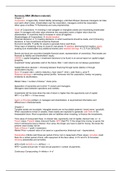Samenvatting
IFA Summary - Chapter 1 - 4 Finance BMA
- Instelling
- Universiteit Utrecht (UU)
UU Introduction to Finance and Accounting - Summary of Chapter 1, 2, 3 and 4 (1-4) of 'Principles of Corporate Finance' by Brealey, Myers and Allen (BMA)
[Meer zien]




